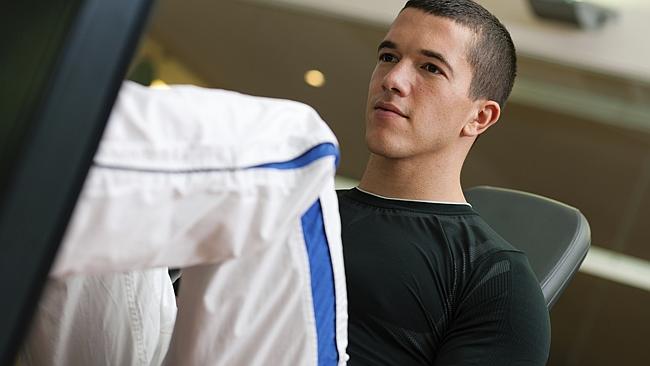Does cardio ruin your muscle gains?
FOR anyone trying to pack on muscle, cardio can be a dirty word. But will a run around the block really destroy your new bulk? Experts give us the skinny.

MOST guys who get seriously interested in building muscle also get seriously paranoid about anything that could slow down (or completely stop) their muscle gains.
They work so hard for every gram of lean body mass and every added plate on the bar, they don't want anything compromising their gains.
No question is more worrisome to the muscle-seeker than whether cardio will help or hurt the quest.
Fortunately for you, if you're one of the many guys with this dilemma weighing on your mind, advancing research is finally giving us some answers.
The concerns about cardio interfering with strength and muscle growth are not unwarranted. Doing aerobic and strength training at the same time, also known as "concurrent" training, has been studied by exercise scientists since the 1980s - and there's bad news.
When too much aerobic work is added on top of a strength or hypertrophy (muscle growth) program, there is an interference effect.
Once the cardio duration, frequency and or intensity cross a certain threshold, muscular power, strength and size can all be compromised - in that order.
But cardio can do good things for your body, such as boosting metabolism, speeding up fat loss, improving heart health and increasing cardiovascular fitness.
It would be nice to take advantage of those benefits and reap the rewards of resistance training for strength and muscle at the same time. The good news is, you can. The key is finding the right balance.
So how much cardio is too much?

At least four different studies on concurrent training came to one shared conclusion: If the cardio (i.e. aerobic or endurance training) does not go beyond 20 to 50 minutes (depending on the intensity) and doesn't exceed three days a week, there is little or no interference effect.
As cardio training goes beyond these levels, the risk of compromising strength and muscle increases.
Does this mean you should never do more than three days per week of cardio? Not necessarily. If you finish up a muscle gaining program (a "bulking cycle") and your goals change to fat-burning (a "cutting cycle"), increasing the cardio frequency can help you get leaner faster - and who doesn't want that?
The key to smart training is not being scared of cardio, but simply knowing your priorities. Competitive body builders are a perfect example and regular guys can take a cue from them: Body builders are known for doing cardio every day before competitions and, as we can plainly see by the amazing physiques, they get on stage ripped and with all of their muscle intact.
What studies on concurrent training are really telling us is that during the bulking cycles when muscle and strength are your priority, keep your cardio to a minimum - three days a week at most (and skinny hard-gainers might want to skip the cardio altogether).
During the cutting cycles, when getting leaner is your priority, increase your cardio when you need to get leaner faster or break a plateau.
This practice of varying the cardio amounts throughout the year depending on your goal is known as cardio periodisation. If you're still worried about losing your hard-earned muscle, all you have to do is track your body composition during your cutting cycle and if your lean body mass decreases, simply back off the cardio a little.
Another big question a lot of guys have is whether certain types of cardio are better than others. A new paper published in the Journal of Strength and Conditioning Research has shed some light on this.

Researchers at the University of Tampa, Fla. found that muscle growth is not compromised as much from stationary cycling as it is from running.
They said that it was probably because the muscle contractions during cycling are more concentric in nature, while the muscle contractions during running are more eccentric. Eccentric muscle contractions, where the muscle lengthens, may cause more muscle damage.
This matches what strength athletes have known intuitively all along: If you're trying to beef up your legs, or even maintain the lower body muscle you already have, long distance running is not the ticket.
Sprinting, on the other hand, including high-intensity interval training (HIIT), maintains or even helps boost muscle growth. But even the ever-popular HIIT comes with a catch.
Interval training is a highly effective mode of cardio training and, more importantly for busy guys, highly efficient - since you can often get equal or greater results in half the time.
Here's the problem: The science says that sprinting and HIIT workouts are a lot like leg training. So if you have a "leg day" when you do squats, lunges or other weightlifting exercises with high intensity two or more times per week, and you add HIIT four or five times a week on top, that's like doing leg day every day. Overtraining city!
Contrary to some of the ultra-intense-all-the-time training programs and philosophies that have gotten really trendy lately, low- and medium-intensity steady-state cardio has its place after all.
Even when you're cutting, it's best to limit your high-intensity cardio to two or three times per week.
What if you want to add more cardio to accelerate fat loss? Go right ahead - but keep the intensity low to moderate for those additional sessions, which may even serve as active recovery. Your leg muscles will thank you.
This story originally appeared at AskMen.
###



